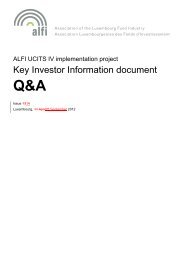Real Estate Investment Funds: Financial reporting - Alfi
Real Estate Investment Funds: Financial reporting - Alfi
Real Estate Investment Funds: Financial reporting - Alfi
Create successful ePaper yourself
Turn your PDF publications into a flip-book with our unique Google optimized e-Paper software.
What information in respect of investments in real estate funds should fund managers/<br />
accounting teams/administrators collect and consider when calculating the Fund NAV<br />
of a FOREF?<br />
This information will typically include a mixture of direct source information and<br />
additional supporting information. The information should be addressed to the<br />
fund manager, the FOREF’s governing body and/or the pricing committee.<br />
Examples of both types of information are listed below. These lists are neither all<br />
necessary nor exhaustive:<br />
1. Direct source<br />
information<br />
a. NAVs/financial statements of the "investee<br />
fund" (in order of preference)<br />
QQ<br />
Audited, as at the date of the FOREF valuation;<br />
QQ<br />
Audited, close to the date of the FOREF<br />
valuation (either before or after) for noncoterminous<br />
period-ends;<br />
QQ<br />
Unaudited, as at (or close to) the date of the<br />
FOREF valuation;<br />
QQ<br />
Provisional, as at (or close to) the date of the<br />
FOREF valuation;<br />
b. Details of all capital calls made to/distributions<br />
received from the "investee" funds since the<br />
last valuation of the "investee" funds;<br />
c. Detail of significant subsequent events since the<br />
last date of the NAV calculation of "investee" funds,<br />
due to the potential mismatch of the NAV frequencies<br />
between the investee funds and the FOREF.<br />
2. Additional supporting<br />
information<br />
a. Additional financial and operational<br />
information received by the FOREF under<br />
the terms of side letter arrangements with<br />
the "investee" funds.<br />
b. Information in respect to the control<br />
environment of the "investee" funds – this<br />
could include an understanding of the<br />
governance framework of the "investee" fund as<br />
well as specific reports on controls matters such<br />
as long form reports (where applicable). This<br />
will also include judgments around the quality<br />
of the promoter as well as service providers such<br />
as the administrator, valuers and auditors.<br />
c. Analyses of historical accuracy of provisional<br />
NAVs released by "investee" funds by comparison<br />
to those contained in audited accounts.<br />
d. Independent valuers’ reports for the real<br />
estate portfolio of the "investee" fund.<br />
e. Analyst or valuers reports regarding market<br />
conditions and valuations of the geographical<br />
and sector markets in which the "investee"<br />
funds have invested.<br />
f. Meeting minutes or call logs between the<br />
FOREF and the "investee" fund.<br />
g. Minutes of any meetings of supervisory bodies<br />
of the "investee" fund in which the FOREF is<br />
represented – e.g. investor advisory committees.<br />
h. Confirmations from management/<br />
administrators of the "investee" funds in<br />
respect of their valuations/NAV.<br />
i. Confirmations from custodians regarding the<br />
existence of investments in "investee" funds.<br />
3. Use of information<br />
received from<br />
investee funds<br />
a. It is important that this data is not just<br />
collected - the valuations that are assigned to<br />
each investment within the FOREF’s portfolio<br />
should fully take into account all of this<br />
information. In other words, those deciding<br />
on the valuation of individual assets that will<br />
be included in the calculation of Fund NAV<br />
and financial statements of the FOREF,<br />
whether the FOREF’s governing body, a<br />
pricing committee or a third-party<br />
administrator, need to have access to this<br />
monitoring information.<br />
b. Consideration also needs to be given to the<br />
process of how this information is utilised in<br />
arriving at valuations and how this is<br />
controlled – for example the existence of, and<br />
input from, a valuation committee or the fund<br />
manager. This means that there must be<br />
adequate processes and controls at the<br />
FOREF level to monitor, utilise, and challenge<br />
the information received to enable this<br />
information to be used when determining<br />
the FOREF NAV.<br />
c. Of particular concern are changes in or<br />
conflicts between GAAP, where an investee<br />
fund reports under a different GAAP to the<br />
one adopted by the FOREF. The FOREF’s<br />
governing body should decide how such issues<br />
should be resolved when they establish the<br />
FOREFs valuation policy.<br />
31

















